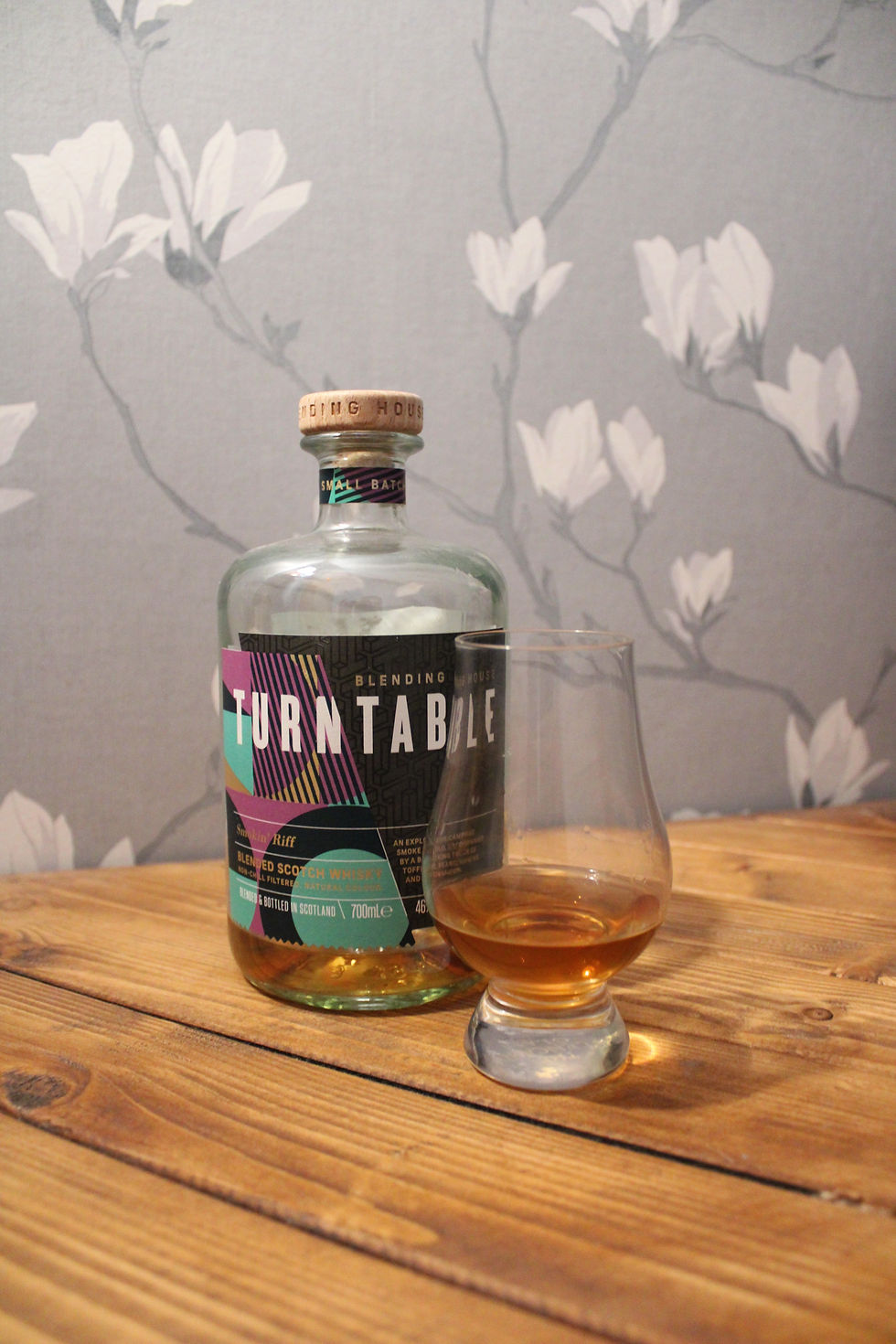Turntable Smokin' Riff
- Triple Tipple
- Aug 20
- 4 min read

The Maker
Turntable Spirits is the brainchild of Glasgow based brothers Ally and Gordon Stevenson. They are the second generation of Stevenson to make their careers in the whisky industry and each have over twenty years experience at distilleries as diverse as Old Pulteney and BenRiach.
They decided to set up Turntable at the backend of the Covid pandemic with the aim of focusing on blended whiskies. While malt is all the rage among whisky nerds, it's easy to forget that blended whiskies (malted barley and other grains) still make up the vast majority of all whiskies sold around the world.
As malt whisky prices increase they thought it was only natural that the window for transparent, high-quality blends would open up, and Turntable's ambition was to be the first in line to capitalise on it. Several years on I'd suggest that the growth of upmarket blends from independent bottlers is still in its infancy, with the likes of Living Souls, James Eadie, Thompson Bros and North Star Spirits trying a similar pitch in the marketplace with mixed success. Instead, I'd argue that we've seen more success in the blended malt category (malts from several distilleries but without grain) led by the likes of Springbank/Kilkerran and Glen Scotia with their much loved Campbeltown Loch.
Nonetheless, I'm not aware of any of those blends that are giving the level of transparency which Turntable has developed in so short a time, with a core range of three malt dominated releases that change in make up by the batch. Alongside this core range has been a series of special releases and partnership bottles, many of which are still available from their website.
The Expression
This edition of Smokin' Riff is from late 2023 and is, as far as I can establish, from the first batch released. It comprises of 72% malt whisky from three distilleries and a 28% grain component from the North British distillery. While the grain was matured in virgin oak (origin unknown), the malt majority is a little more interesting.
In size order the largest component is 24% from a Craigellachie PX puncheon; followed by 21% from a Knockdhu PX puncheon; then 18% from a Caol Ila bourbon barrel; and then 9% again from Caol Ila, but this time an ex-red wine barrel. So that's 27% Caol Ila goodness in total.
It's bottled with integrity, meaning it's 46% and free of any colouring and chill-filtration. The only gap here is an age statement which is reportedly prevented by Scotch Whisky Association regulations. Apparently having the ages as well as sources was considered a step too far, so transparency on the split and make-up was rightly prioritised.
Far be it from me to ever be critical of the fine people at the Scotch Whisky Association, but when the likes of Lord [David] Frost have come from there, it's all too easy to question their judgement.
The Neck Pour
It's immediately full of grassy grains on the nose. Very light and sweet smelling with acres of barley sugar and serial notes. What isn't here, to my surprise, is much Coal Ila considering it’s a major element and that oily peat is normally so prominent. Nor am I getting those rich syrupy PX notes.
The taste is very light and rounded all the same. There's lots of sticky toffee pudding in here which speaks to the Craigellachie and Knockdhu elements. There's a hint of smoke on the finish but not much. Very drinkable and inoffensive.
The Body
The bottle has been open around 8 months now and over time the peat element has become far stronger on the nose. As a result there's now a hefty dose of boot polish, but not the traditional oily, smoked fish notes of Caol Ila.
This follows onto the palate. Those lighter toffee pudding notes are still here but have fallen into the background compared to the peat. The addition I'm also getting at this point is a light banana liquor, and perhaps even a whiff of lavender on the finish along with toasted hazelnuts.
Final Thoughts
More than a year has passed since I first opened this bottle and in that time the peat notes have only got stronger. Now there's plenty of oil that's heading towards a hint of antiseptic - sort of like that banana flavoured medicine you had as a child.
But despite this the grain is still present. If anything the depth and complexity is only increasing with time. There’s almost an industrial funk to it which isn’t a million miles from the Campbeltown Loch, only with much more peat.
On the palate it’s much the same story with the Coal Ila now dominating. Under the surface there is still that sweetness of burnt honeycomb and perhaps even a little salt water taffy.
Where this falls down is when you have it after a single malt. For all that is good about this, it just doesn't quite cut it when compared to a good malt. Nonetheless on an evening when you just want one dram, or need a ‘calibrator dram’ to get the palate going then it really can’t be faulted. I’m very tempted to explore more of the range to bolster my lacklustre blends collection.

![Springbank 18yo [2024 Edition]](https://static.wixstatic.com/media/c77be6_ac802672664340118e5d049ca8bff528~mv2.jpg/v1/fill/w_980,h_1470,al_c,q_85,usm_0.66_1.00_0.01,enc_avif,quality_auto/c77be6_ac802672664340118e5d049ca8bff528~mv2.jpg)
![Ballechin 18yo [Batch 001, 2023]](https://static.wixstatic.com/media/c77be6_6bb627d30ffd4074b93b86e598b748b4~mv2.jpg/v1/fill/w_980,h_1470,al_c,q_85,usm_0.66_1.00_0.01,enc_avif,quality_auto/c77be6_6bb627d30ffd4074b93b86e598b748b4~mv2.jpg)

Comments